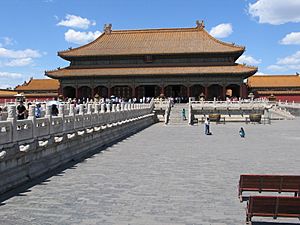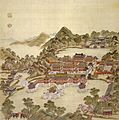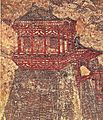Chinese architecture facts for kids
Chinese architecture is all about the amazing buildings found in China. Sometimes, it also means buildings outside China that look just like those in China. This style of building has been super important in East Asia. Many other countries and cultures, like Korea, Vietnam, and Japan, have copied Chinese building ideas. Two famous examples are the Great Wall of China and the Forbidden City.
The basic ways Chinese buildings are put together haven't changed much over time. Only the small decorative details have changed. Since the Tang Dynasty (which was a long, long time ago!), Chinese architecture has really shaped how buildings look in many nearby countries.
Contents
Types of Chinese Buildings
Homes for Everyday People
The houses of regular people, like government workers, shopkeepers, or farmers, usually followed a simple plan. The middle of the house often had a special place for gods and ancestors. This area was also used for celebrations. Bedrooms for older family members were on either side of this central space. The two "wings" of the building (which Chinese people sometimes called "guardian dragons") were for younger family members. This is also where the living room, dining room, and kitchen were located.
Sometimes, families grew very large, so they would add one or two more "wings." This made the building U-shaped, with a courtyard in the middle. This courtyard was great for farm work. However, merchants and government workers often built a big, impressive gate at the front to close off their courtyard. There were even laws about how buildings could be built! The number of floors, the length of the building, and the colors used depended on how important the owner was. Some commoners in dangerous areas built strong, shared fortresses called Tulou to stay safe.
Buildings for the Emperor
Certain building features were only allowed for the Emperor of China. For example, only imperial buildings could have yellow roof tiles. Yellow was the Emperor's special color! You can still see yellow roof tiles on most buildings inside the Forbidden City. But the Temple of Heaven is different; it has blue roof tiles to represent the sky.
Roofs on imperial buildings almost always have special wooden supports called "dougong" (bracket sets). Only the biggest religious buildings also used these. The wooden columns and walls of imperial buildings were often painted red. Black was also a popular color, especially for pagodas. People believed that black helped gods come down to Earth.
The Chinese 5-clawed dragon was a special symbol for the first Ming emperor. It was used as decoration on beams, pillars, and doors of imperial buildings. But strangely, you would never find dragons on the roofs of these buildings.
Only buildings used by the imperial family could have nine jian (間), which means nine spaces between columns. Also, only the gates used by the Emperor could have five arches. The middle arch was always just for the Emperor! Ancient Chinese people really liked the color red. Buildings usually faced south to avoid the cold winds from the north.
Numbers were very important in Imperial Architecture. The number nine was often used because it's the biggest single digit. This is why the Forbidden City in Beijing is said to have 9,999.9 rooms. This is just a tiny bit less than the mythical 10,000 rooms in heaven!
City Planning and Design
Chinese cities were planned using ideas from fengshui and the well-field system. Fengshui is about arranging things to be in harmony with nature. The well-field system was a way of dividing land that has been used since ancient times. These ideas helped decide how cities were laid out, often using a special "magic square" called the luoshu.
Images for kids
-
A colorful ceramic model of a mansion from the Tang Dynasty.
-
Han yuan tu by Li Rongjin, Yuan dynasty.
-
Jianzhang Palace, Yuan dynasty.
-
Nanchan Temple (Wutai), built in the late 8th century during the Tang Dynasty.
-
A timber hall built in 857 during the Tang Dynasty, at the Buddhist Foguang Temple.
-
Models of watchtowers and other buildings from the Han dynasty.
-
A stone-carved pillar-gate, or que, from the Han dynasty.
-
Ruins of a granary built during the Han dynasty.
-
Remnants of the Great Wall of Qi from the Warring States Period.
-
The Great Wall of China at Mutianyu, built during the Ming dynasty.
-
A pavilion inside the Zhuozheng Garden in Suzhou.
-
The Zhaozhou Bridge, built from 595 to 605 during the Sui dynasty.
-
Nanshan Temple in Longkou, Shandong.
-
Lianhuashan Temple in Dalian.
-
The Nine Pinnacle Pagoda, built in the 8th century during the Tang Dynasty.
-
A Chinese pavilion instead of a minaret at the Great Mosque of Xi'an.
-
The Fogong Temple Pagoda, built in 1056, the oldest fully wooden pagoda in China.
-
The Giant Wild Goose Pagoda in Xi'an, rebuilt in 704 during the Tang Dynasty.
-
The Liuhe Pagoda of Hangzhou, built in 1165 AD during the Song Dynasty.
-
A timber hall built in 857 during the Tang Dynasty, at the Buddhist Foguang Temple.
-
The Liaodi Pagoda, the tallest pre-modern Chinese pagoda, built in 1055.
-
The Ho Ancestral Hall in Panyu, Guangzhou; built in 14th century.
-
A monument in honor of the Cantonese folk hero Wong Fei-hung, in Foshan.
-
A Mazu temple in Shek Pai Wan, Hong Kong.
-
A Mazu temple in Chiayi City, Taiwan.
-
A shrine for Tudigong, a Taoist earth deity, in Kaohsiung, Taiwan.
-
Confucian academy in Fuzhou.
-
A "Pai tau uk" (牌頭屋) in Nanchang, Jiangxi.
-
Shikumen in Xintiandi lanes in Shanghai.
-
Great Wall of Qi in Shandong.
-
Jinci in the Jin Chinese-speaking province of Shanxi.
-
An enclosing courtyard from the Astor Court in the Metropolitan Museum of Art, New York City, USA.
-
The yellow roof tiles and red wall in the Forbidden City (Palace Museum) grounds in Beijing.
-
A pottery model of a well from the Han dynasty.
See also
 In Spanish: Arquitectura china para niños
In Spanish: Arquitectura china para niños
































































